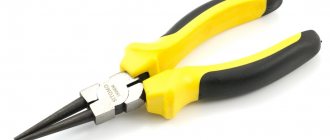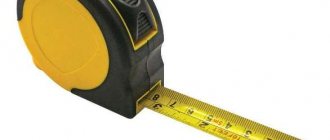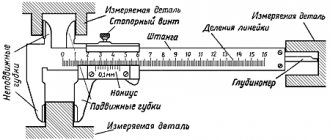Hand braid purpose
A hand scythe is used for making hay and animal feed, mowing tall or tough grass, trimming the lawn and plants on the site, and even harvesting grains.
This tool has a simple design that differs slightly in different configurations.
Design, characteristics and principle of operation
A hand braid consists of the following elements:
- The blade is a curved long one-sided blade, the reverse (non-sharp) part of which is called the butt. The place where the blade meets the butt is called the nose.
For fastening with a braid, in the part opposite from the nose there is a heel and butt. The braid blades may differ in length, which directly affects the gripping area, as well as in shape. - The braid is a cutting on which the canvas is planted, also known as a braid. It can have either a straight or curved shape.
The blade has an inclination relative to the mower, which allows the blade to be kept horizontal relative to the ground during operation. - Handle – installed perpendicular to the braid, provides a comfortable hold of the tool during work (usually at the level of the navel). The option that goes around the stalk is called an onion.
- Wedge - used to attach the canvas to the braid.
- The braid ring is another element for attaching the canvas to the braid. Together with the wedge, it immovably connects the braid and the canvas to each other. This ring comes in several types. Sometimes two rings are used.
- Twine is a strong thread that is used to create an adjustable handle with a clamp-like design.
All braids operate on the same principle, differing only in some details.
During the work process, the mower performs sweeping movements with the tool, which are divided into such components as the “swing” and the “working phase”.
During the second action, the scythe is used to simultaneously separate a certain number of plant stems from the main mass with its nose and mow them down.
Material
The working part of the scythe is made of tool steel grades U8 and U7; the material for the scythe is strong elastic wood, such as spruce, sometimes pine and birch, coated with a wax solution.
There are also metal braids; they are made from light metals such as aluminum and other similar alloys.
The wedge is cut from dry wood. The handles are also made mainly of wood, sometimes of plastic.
Dimensions and weight
The length of a classic scythe is 1.7 - 2.2 m, however, for some types of this tool the handle may be shorter - from 1.4 m.
The width of the scythe is essentially the length of its blade and can vary widely.
So, for example, with “Serpan” it cannot exceed 350 mm, and “Litovka” can boast a 0.5 - 1 meter blade.
In the latter case, by the way, sizes from N5 to N10 have been introduced, where the digital designation corresponds to the length of the canvas, expressed in decimeters.
At the moment, for all types of braids, an extended size classification within the limits of N4.5 – N10.5 can be applied.
The width of the canvas is usually 40 - 43 mm, and the weight is 255 - 750 g.
The bend radius point of the scythe is approximately 110 cm from the blade, usually corresponding to the location of the handle.
Types of scythe handles
There are two types of auxiliary scythe handle:
- motionless - reliable and stable, inserted into the body of the braid.”
- adjustable, convenient because it allows the tool to be used by several people of different heights.
Most often made from bird cherry or willow.
The diameter is 25 – 30 mm, and the length is 350 – 400 mm.
The pole bends around the braid and is tied with twine.
Adjusting the cutting height on a lawn mower
The design of the lawn mower involves adjusting the cutting height of the grass. Range may vary between models. Equipment manufacturers indicate the minimum and maximum values of this parameter in the accompanying documentation. Inexpensive models most often have 3 interchangeable height positions; more expensive and advanced models may have 5-7 adjuster positions.
To care for lumpy lawns, you usually choose a model with a wider range of height adjustment.
Different models may have different technical solutions for choosing the cutting height. There are two types of regulation: manual and mechanical. The first involves stopping the engine and manually changing the position of the regulator. The mechanical method allows you to change the cutting height by pressing a button on the control lever, without interrupting the process.
Types of hand braids and their prices
Whatever the working conditions are, the braids are made the same way.
In other words, each type of tool was initially created to perform very specific tasks.
Spit "Litovka"
She is also a braid-stand - has become the most widely used.
It sharpens well and holds an edge for a long time thanks to the use of tool steel in production.
The main differences: the length of the handle is up to 2.2 m and the presence of a beam, a straighter blade, which has a pronounced rounding towards the end.
During work, it ensures that the mower maintains a straight back.
Cost 1000 – 1500 rubles.
Spit "Pinkbush"
It is also called “Bagpipe” – its shape resembles a large sickle, it has a curved handle of shorter length, it is used in places with a lot of unevenness or with difficult access, for example, when trimming trees and stumps.
While working, the mower has to bend over.
The price of this tool is about 600 rubles without the handle.
Bush braid
A more massive tool, with a blade 400mm long, sharpened in a special way.
Designed for mowing thick dry grass, burrs, weeds and small shrubs.
The cost is within 500 rubles.
Spit "Serpan"
It is also called “Serpanka” – it is small in size and is used for mowing dry grass, plants with rather thick stems, thickets, and bushes.
The length of the braid is usually about 500 mm, but there may be other sizes.
Here you can also include a folding Chinese sickle, which by all appearances is more consistent with a mini-braid than with a sickle with its characteristic bend of the canvas.
Price 700 – 900 rubles.
Scythe-cleaver
The tool is similar to the previous version, but the length of the braid is 120cm, the blade size is up to 40cm.
Working with this scythe does not require any special skills; mowing is done with cutting movements across the plants just above the ground.
Designed for mowing tough grass and small shrubs.
Folding braid (transformable)
Modern modifications of the tool, where the braid can be either metal or wood, the main feature is that the blade of the scythe, and in some models the braid, are collapsible.
The folding scythe can be easily disassembled and assembled, which is convenient for its transportation and storage.
A manual scythe, in comparison with the same trimmer, is silent, and a skilled mower will definitely outperform the operator of a gasoline or electric version of this tool in the speed of working with a trimmer in large open, flat areas.
Hand scythes are produced not only for use, but also as souvenirs.
Souvenir items undergo more careful processing and can be decorated with various patterns, because... They are most often produced by hand.
At the same time, the souvenir braid is quite suitable for mowing, because... The production technology is in no way inferior to, and sometimes even surpasses, the popular options in quality.
Use of special equipment
Not everyone will like to “wave the scythe,” especially if the “subordinate” territory has a large area. Therefore, most owners of suburban areas prefer to use more convenient and more or less independent helpers.
Mechanical (manual) lawn mowers
These designs are quite simple. They look like carts with two wheels. Between them there is a drum with knives. Such a mower starts working when a person sets it in motion. The knives move when the wheels rotate. The cuts are smooth. This method, unlike the braid, guarantees higher speed.
Manual lawn mowers have several advantages over their competitors. These include:
- simplicity of design and equally easy work;
- ease of maintenance and no need for fuel or electric motor;
- absolute environmental friendliness, safety and fairly silent “activity”.
- the ability to mow grass only on level ground;
- inability to control weeds.
Another undoubted advantage is the low price of such manual equipment.
Manual units also have disadvantages. This:
With regular use of mechanical lawn mowers, owners will have to systematically sharpen their blades.
Wheeled lawn mowers and riders
These machines are more advanced because they require the slightest effort from the owners. Lawn mowers are divided into three types - battery-powered, gasoline-powered and electric. Riders come in petrol and battery only. Such units are practically free of drawbacks, but you will have to pay for convenience, and a considerable amount.
Types of equipment
Gasoline models have an engine that runs on a fuel mixture. Their knives are also located in the lower part of the body; they are no longer driven by wheels, but by the motor shaft. Their main difference from other equipment is the presence of four wheels.
Lawn mowers are equipped with handles that contain control levers. Mown vegetation is collected in a special container - a grass catcher. Its volume depends on the model. There is another type of lawn mower with a mulching function. Such equipment does not collect grass, but scatters it over the surface of the lawn. There are also more universal models that provide both a grass catcher and the ability to mulch.
Gasoline devices are the most complex and demanding type. Such machines require the correct proportions of the fuel mixture (gasoline and oil) and the use of suitable petroleum products. These units are started according to the instructions.
Battery and electric lawn mowers are easier to operate. They work just as efficiently. The difference between the devices is the operating principle of the engine. There are no other differences (in configuration, functions).
Features of working with lawn mowers
It is quite easy to learn how to use such equipment. However, the first step is to try mowing plants of different heights. This step will help you understand how to operate the lawn mower. The work includes several stages.
- First, the area is checked for potential interference. Stones, twigs, branches and other large debris are removed from the territory.
- The cart is placed on a flat surface, then the equipment is inspected. Make sure that the elements (knives) are securely fastened. In gasoline models, the amount of fuel is checked.
- Then the machine is turned on. Gasoline lawn mowers are started with a starter. First, the cord is pulled out all the way, then it is sharply pulled towards itself. Electrical devices can be turned on much easier - with a button.
- Working with the equipment is as simple as possible: the cart is rolled in the desired direction. The movement should be smooth, even, without jerking. If there is a need to go back, first turn off the lawn mower and only then move it.
Electric models are not recommended for mowing wet grass, since it is possible that the person working with it will receive an electric shock.
Self-propelled lawn mowers
This equipment promises owners comfort with a “bigger” letter. It can have either front- or rear-wheel drive. These lawn mowers move independently: they only need to be given a direction. This technique is an excellent solution for medium or large lawns.
The advantage of self-propelled guns is that there is no need to make any effort. Teenagers, women and elderly people can work with the units. Disadvantages - higher price, inconvenience when mowing small lawns, since you will have to change direction very often. For these reasons, self-propelled vehicles are rarely used in summer cottages. She needs space - fields.
Garden machines - riders
Riders are larger versions of lawn mowers because they have a similar mowing system. Their main differences from competitors are dimensions, different controls, as well as “appearance”. The Raider is a car in miniature: it has a very comfortable seat and a real steering wheel.
Robotic lawnmowers
These are relative new products that, like robotic vacuum cleaners, can handle the job on their own. The devices operate on rechargeable batteries. The downside of this option is the high price of such compact equipment. However, the list of benefits of lawn mowers is impressive.
The devices mow the grass in a given area without the participation of the owners. The “smart” system built into the equipment gives them the ability to accurately determine the working area, avoid all obstacles along the way, and also find the place where the charger is located.
Robot mowers are equipped with an alarm to prevent theft of the smart device. Most models have rain sensors, so they won’t “go to work” in wet weather. Or they will return to the canopy if precipitation begins during mowing.
Robots do not have a grass collector, since they only cut a few (tens) millimeters. The width of the mowing strip is 250-350 mm, the cutting height is from 15 to 60 mm. Some lawn mowers are capable of mowing up to 400 m2, and the area can have a slope of up to 35°.
Trimmers
These devices are a mobile version of garden equipment. Such equipment includes a motor, a trimmer head and a cutting tool - a knife, disk or fishing line. These elements can be made of plastic or metal. The trimmer head is connected to the motor by a rod, but which houses a lever for controlling the device and a handle for ease of operation. An additional element for maximum comfort is a shoulder strap.
Models of trimmers are also divided into several types - gasoline, electric and battery-powered. The former also run on a fuel mixture, the latter require electricity, so an outlet nearby is a must. Cordless trimmers are lightweight, so these devices are optimal for women and the elderly. The downside is their limited operating time: the devices will have to be charged periodically.
Advantages and disadvantages of trimmers
The advantages of this type include:
There are some drawbacks, but they are related to the characteristics of specific models. The list includes:
Now about how to mow grass with a trimmer. Working with this equipment is very similar to handling a hand scythe.
- First, the device is turned on, the bar, like a simple instrument, is also held with both hands.
- Then use smooth movements with the trimmer from left to right or forward. This type of mowing does not require any serious effort.
What's the best way to mow grass? A trimmer is one answer to this question. He is mobile, almost “omnivorous”, since he can get to any place on the site.
How to choose a hand braid?
As a rule, the size of the scythe is selected individually by each mower, taking into account both personal preferences and the area where the mow is to be mowed.
So, for example, for working in the garden, where you have to “go around” trees and shrubs, blade numbers 5 and 6 are preferred, and the latter is considered optimal for a wide range of tasks.
In cases where mowing is planned on a large area, such as a field or meadow, preference is given to scythes with numbers above 6.
As for choosing a knife based on quality, you should pay attention to the absence of any visible damage, such as delamination or cracks.
Irregularities in the blade, changes in its thickness in any area indicate non-compliance with the manufacturing technology, and as a result, the substandard quality of the tool.
NOTE:
The quality and integrity of the braid steel itself can be determined by the sound.
To do this, you need to take the canvas itself by the heel and hit the butt against any massive wooden object.
A clear, clean ringing is evidence of a good instrument.
If you liked the article, please share it
Previously on the topic:
Share
How to use a hand scythe?
The working technique depends on the type of scythe chosen, however, you should always mow carefully, following safety rules.
During the work, it is necessary to control the position of the limbs, in particular the legs, as well as the blade itself, at least at first, until all movements are developed to the point of automaticity.
How to mow with a scythe?
When working with a litovka, as already mentioned, a straight back is maintained; this is ensured by the correct installation of the handle at the appropriate height for a particular mower.
The scythe is held with the left hand above the handle, and with the right hand by the handle itself.
The left leg is moved slightly back, and the right leg forward.
The body is moved slightly forward and kept slightly turned.
During the mowing process, the spout rises up, which prevents it from burying in the ground and ensures uniform cutting of the grass.
An important feature is the observance of circular movements from right to left, and the swings are carried out more by turning the torso than by the arms, and they should not be excessively wide.
How to mow pink salmon with an oblique? video
When working with an oblique pink salmon, two swaths are made in one step; the process itself requires a lot of experience.
The braid spreads its legs wide, leans forward, and swings to the left, and on the braid, the right hand is behind and the left hand is in front.
After performing this movement, the back straightens a little, and the braid turns (with its nose through the bottom, which is easier and safer) in the opposite direction, at the same time the position of the hands changes.
Next, the mower moves a little forward, bends again and performs a working movement to the right.
Why is it better to mow wet grass?
As you know, mowing with a hand scythe is usually done in the morning, and this process continues until the dew disappears.
This is due to the fact that wet grass is heavier than dry grass, and therefore provides significant inertial resistance to the tool blade.
The result is a stepwise increase in the efficiency of the scythe.
Wet grass is much easier to mow.
For comparison, dry grass, even with a well-sharpened blade, without providing this increased resistance, is simply crushed.
Additionally, moisture cools the cutting edge of the tool, which contributes to long-term preservation of cutting ability.
Among other things, moisture actually lubricates the tool tightly, reducing the friction force during operation, reducing the force applied by the mower.
When should you mow the grass?
Before moving on to the question of what is the best way to mow grass, you need to get acquainted with the rules of mowing. Vegetation is mowed as it grows. This type of care is most intensive in late spring - late April and early May. As a rule, grass growth increases after rains. It is recommended to mow the lawn in the morning or evening in dry weather. The ideal condition is slightly moist soil.
It is recommended to remove the mown grass immediately, since the left parts of the plants may begin to grow in damp soil. Subsequently, operations are repeated every 1-2 weeks, but the frequency largely depends on the speed of plant growth. Hot weather is a reason to hold off on mowing, as very short grass will begin to fade under the merciless rays of the sun. When cooler days arrive, mowing the lawn twice a month is sufficient. The last mowing is carried out in October.
How to sharpen a scythe?
Sharpening a braid is carried out in two stages:
- Scraping – removes excess metal and makes the surface of the canvas smooth. A scraper is used in the process. When scraping, the scythe is held by the heel, and the scraper is drawn from the base to the edge of the blade along its entire length. After several repetitions, the sharpening angle will be formed, which will no longer change. You can begin editing when burrs begin to form on the cutting edge.
- Editing – allows you to sharpen the blade to a razor sharpness. The tool here is an emery block, which is used in the same way as a scraper, observing the required sharpening angle. Otherwise, the scythe blade may not only not be sharpened, but even become dull.
Before you start sharpening any braid, you need to beat it off (rivet it), thereby creating a working edge.
For these purposes, a hammer and a metal headstock are used, which acts as an anvil.
Both tools can be purchased in specialized stores.
An important condition is the absence of dents on their working surfaces, which usually occur with repeated use.
This is achieved by grinding the planes on a machine.
NOTE:
The cutting edge can be created using exclusively a sharpening abrasive tool, in the sense, without beating, however, after 10 - 15 minutes of work, the blade will have to be sharpened again.
If you first beat off the scythe, its blade will become thin, but at the same time denser, and therefore will retain its sharpness much longer.
Cutting technique
Cutting your grass evenly seems like it should be easy - move the trimmer over the grass and the line will cut it to the desired length. But this is not the best approach and will actually result in bald spots on your lawn. To turn an unruly tool into a reliable machine, it is important to rely on knowledge.
- The ends of the string are where the maximum force of the cutter is concentrated. At the same time, the faster and freer the movements, the easier the process will be. Cone processing. Gives the lawn a beautiful look; the technique works especially effectively along the side of the road, near a fence or trees. Hold the instrument so that the string hits the grass at a slight angle.
- Framing. Where the surfaces are almost parallel, say between a path and a driveway, you want to emphasize the edge. Therefore, we turn the trimmer so that the string is vertical. Then move the tool along the cutting path.
- There is no need to try to use all the techniques at once. If the lawn has never been mowed, then you first need to clear it of debris, then trim the grass to the same length, and only then take on the edges.
- I mow with a trimmer. If you have to work in tall grass, then you can use this simple technique. This means that the tool must move along a U-shape path.
- Screed. Another technique that is used to remove grass growing on paths in cracks. Angle the tool so that the ends of the strings just slide along the road surface, then move into the base of the weeds, cutting them down to a solid surface. But be careful: tilt the tool too much and you'll just break the line. Get the angle too sharp and the line won't be able to cut through the grass evenly.
How to rivet and sharpen a braid correctly? video
For convenient riveting, it is advisable to remove the tool blade from the braid.
As for the features of the necessary tools, you should use a hammer with an absolutely smooth striking surface; any curvature is unacceptable here.
The headstock is a small piece of metal, with a butt protruding just like an anvil, and a point on the opposite side, through which it is fixed.
The point is simply hammered into a suitable piece of wood.
During the beating process, the metal of the blade is pulled back, forming the working area of the scythe.
Riveting is performed on both sides, as evenly as possible, until the required blade thickness is achieved.
High-quality fast batting requires a lot of experience.
Preparing the electric trimmer
If it is raining or has just stopped, you may get an electric shock when cutting wet grass. Before turning it on for the first time, make sure that you have assembled the device correctly - some models are delivered unassembled. Precise assembly will protect you from injury, and the unit itself will protect you from failures and sudden breakdown. Instructions for assembling the trimmer are described in the user manual.
When using an electric trimmer, charge the battery (if the device provides autonomous operation). Lubricate the mechanical gearbox with lithol or grease. If there is no battery in the device circuit, plug the plug into the outlet and start working.
Interesting Facts
- The scythe is an attribute of Death. A skeleton in a robe with a scythe is found in many works of art, films, computer games, etc.
- The scythe is in this case a tool for harvesting souls departing to another world. In the Bible, the harvest is sometimes compared to the reward that people will receive after death. Open 14:18-20: “Use your sharp sickle and prune the grapes on the ground, because the grapes are ripe on them. And the angel cast his sickle on the ground, and cut off the grapes on the ground, and threw them into the great winepress of the wrath of God. And the berries were trampled in the winepress outside the city, and blood flowed from the winepress even to the horse’s bridles, for one thousand six hundred furlongs.”
- The blade of the scythe is capable of producing a sound reminiscent of a bell.
Possible nuances
There are times when it is necessary to mow young grass, and under it lies a cushion of unmown dry grass from last year or even the year before. If you use the method described above, the green grass will be mixed with dry grass. Therefore, for this option, you need to make a special braid with an additional long holder for the left hand.
With this grip, the mowing technique changes slightly. The process involves more hands than the body, and the heel of the scythe no longer lies on the ground. The tool is suspended and only green grass is mowed, while the dry grass remains in its place.
Is it possible to quickly make a mower using improvised materials with your own hands?
The main advantage of homemade mowers is the ability to make them from scrap materials, and their shape and design are maximally optimized for specific conditions. The basis for them can be a walk-behind tractor or a homemade trolley, and the cutting tool is made from a hacksaw blade or other materials.
Since there are a lot of varieties of homemade mowers , we made a separate article about them, which you will find by following this link Homemade mowing machines. Most of these homemade products are distinguished by their simplicity of design and the use of accessible units, but at least minimal metalworking skills are required for production.
Work on mistakes
Those who have just started creating their ideal lawn may encounter many difficulties along the way. If you know how to get around them, lawn care won't be too difficult.
Remove or leave grass clippings
After cutting the lawn grass, it should be removed. An exception can be made only during prolonged dry weather. In this case, a layer of mowed plants will help retain moisture in the soil.
Mown grass should be removed immediately Source pinterest.com
When wet, grass clippings left on the ground will encourage weed growth, loose soil and increase earthworm populations.
Brown color of grass
Sometimes after the lawn is mowed, the grass turns an unsightly brown color at the tips. This may be due to several reasons:
- The grass was wet .
- is not set .
- Dull knives.
- Physical damage or imperfections to moving parts of the mower.
Do I need to fertilize the soil?
Mowing the lawn is not everything to creating a beautiful lawn. Fertilizing and regular watering are a prerequisite for obtaining a good lawn surface. You may have to trim more often, but the quality of the coating will be much better.
Soil feeding Source friscosodgrass.com
Waves: how to deal with them
Another problem that you may encounter is fairly wide waves superimposed on the mown grass. This can happen when the mower is regularly passed in the same direction. To prevent such a defect, it is recommended to change the direction of passage of the mower each time.
How long should it take to cut a haircut: fast does not mean better
Even with modern models of lawn mowers, the cutting process does not go very quickly. On average, tidying up 10 acres of lawn will take at least 2 hours or even more.
10 acres of lawn can be completed in 2 hours Source remax.ca
Order grass mowing: approximately how much does it cost and where to find the service?
Grass mowing is carried out by both enterprises and private entrepreneurs, as well as various “shabatniks”.
The cost of this service depends on factors such as:
- height of vegetation and thickness of stems;
- the ability to use motor vehicles for mowing;
- scope of work;
- terrain;
- the presence of stones on the site;
- time of work;
- additional services, for example, removal and disposal of mowed grass.
You will find detailed information on those who provide such services and the cost of their work here.
Female version
There is an opinion that men are best at braiding, but this is not true. A woman can also learn to mow. Having gained a little experience, female representatives use the braid for its intended purpose no worse than men.
For the first time, it is better to take a tool with a short blade length, since a scythe with a small grip is easier to mow. The number 5 or 6 should be indicated on the canvas - this option will be the most optimal. The grass for the first mowing should be young and of medium size.











